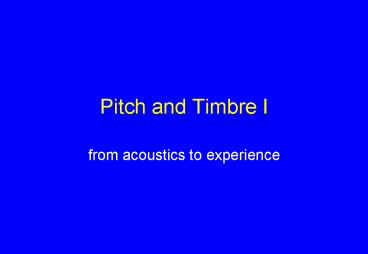Pitch and Timbre I - PowerPoint PPT Presentation
1 / 10
Title:
Pitch and Timbre I
Description:
Sensation and perception. Synthetic versus analytical listening. Definition of Pitch 'Pitch is that attribute of auditory sensation in terms of which sounds may be ... – PowerPoint PPT presentation
Number of Views:106
Avg rating:3.0/5.0
Title: Pitch and Timbre I
1
Pitch and Timbre I
- from acoustics to experience
2
Concepts
- Pitch
- Timbre
- Sensation and perception
- Synthetic versus analytical listening
3
Definition of Pitch
- Pitch is that attribute of auditory sensation in
terms of which sounds may be ordered from on a
scale ordered from low to high - American National Standards Institute (1960). USA
Standard Acoustical Terminology (Including
Mechanical Shock and Vibration) S1.1-1960
(R1976). New York American National Standards
Institute. - Not frequency (although related to it)
- Not sensation
- Implies scale
- Implies one dimension (low/high)
4
Definitions of Timbre I
- The technical definition
- Timbre is that attribute of auditory sensation
in terms of which a listener can judge that two
sounds similarly presented and having the same
loudness and pitch are dissimilar. - American National Standards Institute (1960). USA
Standard Acoustical Terminology (Including
Mechanical Shock and Vibration) S1.1-1960
(R1976). New York American National Standards
Institute. - The musical dustbin definition
- Timbre has always been the miscellaneous
category for describing the psychological
attributes of sound, gathering into one bundle
whatever was left over after pitch, loudness, and
duration had been accounted for. - Dowling, W. and Harwood, D. (1986). Music
Cognition. New York Academic Press.
5
Definitions of Timbre II
- A broader set of definitions
- 1. "the expressive variations available to
performing musicians" - 2. "commonalities shared by all oboe tones, all
bowed violin tones, all timpani tones, and so on" - 3. Broader family distinctions or
method-of-production distinctions "percussive
instruments, whose behavior is determined
completely at the instant when they are set into
motion, and instruments, such as blown and bowed
instruments, whose behavior is controlled
continuously." - Krumhansl, C. (1989). Why is Timbre So Hard to
Understand? In S. Nielzen and O. Olsson (Eds.),
Structure and perception of Electroacoustic
Sound and Music, 43-53. Amsterdam Excerpta
Medica.
6
Acoustic Components of Timbre
- Attack characteristics
- Steady-state spectrum
- Brightness
- Harmonicity
- Amplitude/spectral envelope
- Change in spectrum over time
- Change in amplitude over time
7
Sensation and Perception
8
Perceptual Dimensions of Pitch and Timbre
- One dimensional (pitch)
- Low - High
- Or is it...
- Multidimensional (timbre)
- Dark - Bright
- Unchanging - Changing Spectrum
- Sharp attack - slow attack
9
Analytic versus Synthetic listening
- Analytical
- Simple tone sensations
- Spectral pitch
- Synthetic
- Complex tone sensations
- Timbre
- Virtual Pitch
- Example
- Missing fundamental
- Analytical
- Different spectral pitches
- Synthetic
- Same Virtual Pitch
- Different Timbre
10
Summary
- Pitch and Timbre are perceptual, not acoustic or
sensory - Acoustic (environment)
- An instrument creates vibrations
- These propagate through the air
- Sensory (lower auditory system)
- The ear resolves component frequencies and
amplitudes (analysis) over time - Encoded into nerve impulses
- Perceptual (higher auditory system)
- The mind/brain combines these sensations into the
perceptual attributes Pitch and Timbre































